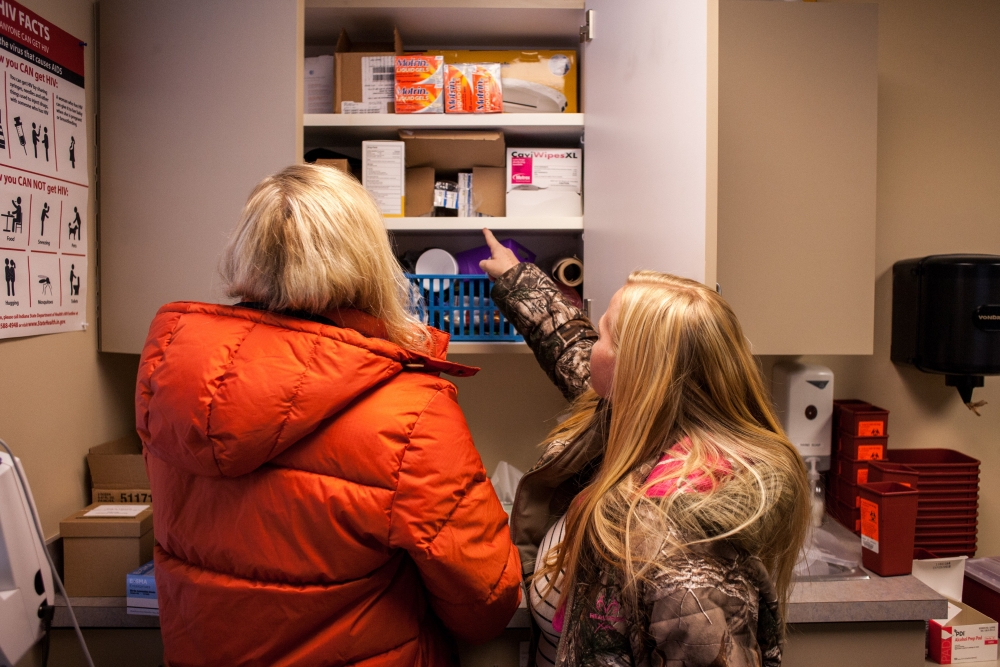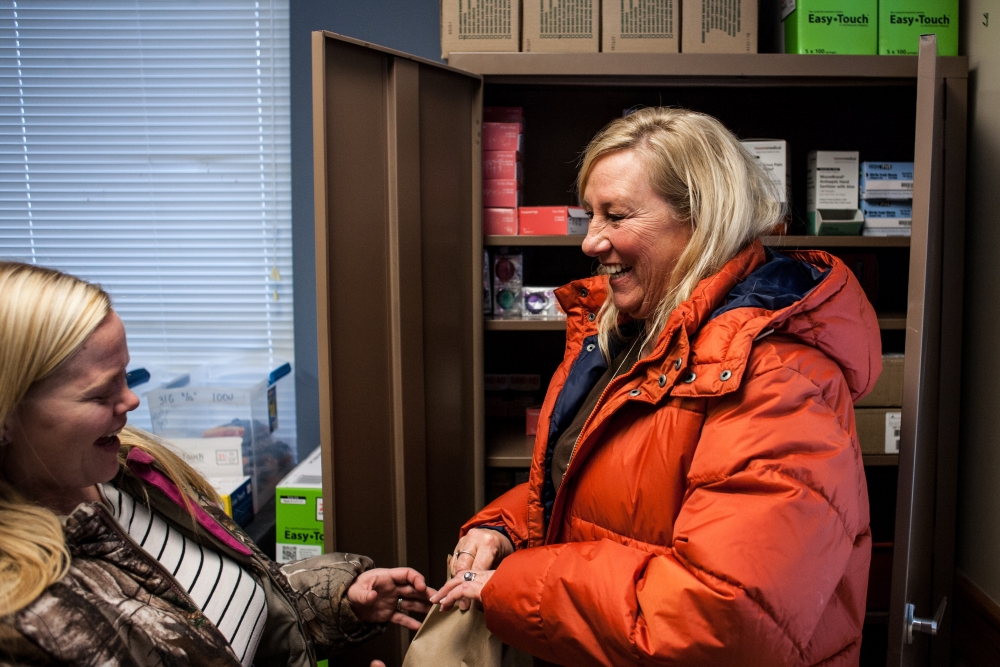

SEYMOUR, IND.—Jackie Crane was at home with her grandson that Sunday night last January when she got the call.
“Jackie, Taylor is in the bathroom. He’s not breathing.”
“What do you mean he’s not breathing?”
It was Sue, her son’s grandmother.
“He’s not moving.”
Jackie, a public health nurse at the Scott County Health Department, thought back to the first time her youngest son, Taylor Newkirk, had been found using heroin. It had been after a car accident, and he had gotten clean, or so she thought. This time it was different.
“I’ll be right over.”
Her kids had asked her to keep a naloxone kit, an opioid overdose antidote, in case of an emergency after they’d found out their cousin and some of their friends had been using heroin. She never thought the first time she’d have to use it would be on her own child.
She ran to her dresser and rummaged around in her underwear drawer until she found the kit.
In the car, Jackie called a coworker.
“How do I do this again?”
“Where does it go?”
“What am I supposed to do?”
When she arrived, she found Taylor on the floor and surrounded by shattered glass and blood with cuts on his arm and thigh. Maybe he passed out, she thought. Had he been trying to hurt himself? She had never seen someone overdose before.
His face was white and soaked with sweat. His lips and fingernails were blue. A slobbery froth bubbled at his mouth. He was barely breathing.
She pulled down his pants and jabbed the needle straight into his upper thigh. She waited, listening to his low guttural grunts. She waited for some movement, some sign.
It’s supposed to work right away, she thought. Why isn’t it working?
She’d only brought the one dose. It wasn’t enough. She didn’t know how long he had left. She fumbled for her phone and called 9-1-1.
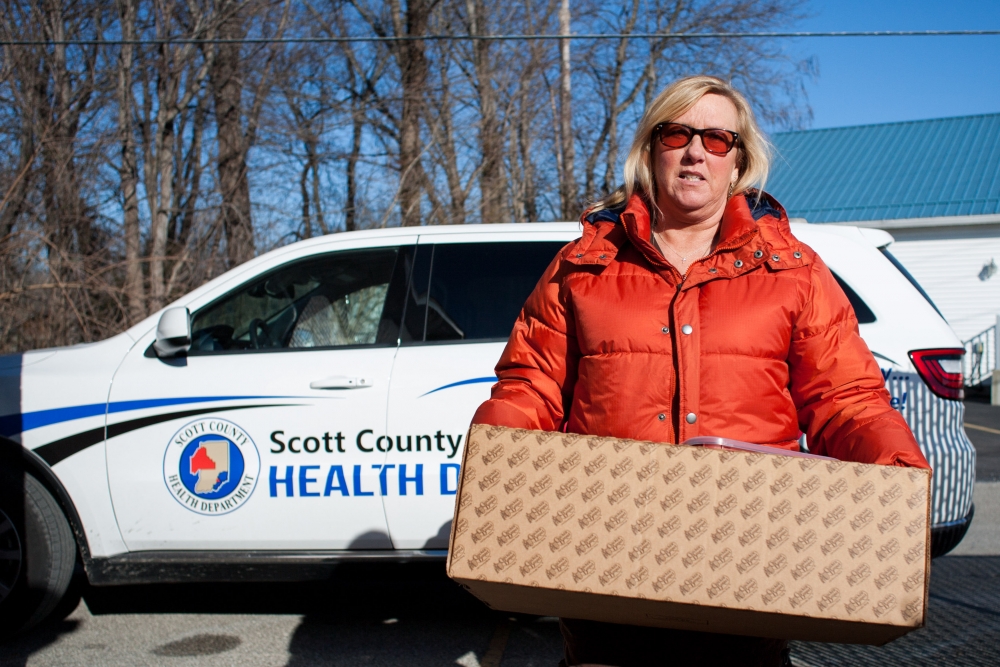
During the last few years, Jackie, 54, has watched heroin become visible in the daily fabric of Seymour, Indiana — hearing about people overdosing, the faces crumbling with pain.
When Taylor, 26, overdosed in January, it became personal.
At work in Scott County, she had seen drug use — severe poverty, drug abuse through generations of families, the outbreak of HIV. She never thought it could happen in her hometown. Not Seymour.
Seymour was home. It was the Crossroads of America, the birthplace of John Cougar Mellencamp, small-town living. People had jobs and nice houses, compared to the severe poverty in Scott County. She assumed heroin was a something that only happened in big cities. How did people even get it? Simple — it was easy, and it was cheap.
She knows better now than to think it couldn't happen in Seymour.
On Aug. 23, eight months after Taylor’s overdose, more than ten people in Jackson County, where Seymour is, and nearby Jennings county overdosed in a span of a few hours. They’d used a bad batch of heroin laced with the highly addictive painkiller fentanyl. There was one death.
That happened on a Tuesday. On Wednesday, Jackie was already making plans for a way to help.
She organized a naloxone education and distribution event with nonprofit Overdose Lifeline on Aug. 29 in Harmony Park.
About one hundred people showed up. They were mothers, fathers, sisters, brothers, teachers, nurses, lawyers and politicians. All of them had someone in their family who needed help.
Many were people Jackie had known for years. She didn’t realize they or their families had been struggling with addiction, too. She thought she was the only one.
By the end of the day, Jackie had given out 62 free naloxone kits, about a third of the 200 kits the Jackson County Health Department is allotted from the state for the entire year. It’s a number public health coordinator Lin Montgomery in Seymour says is not big enough.
It was the most Jackie had ever seen handed out in a day.
For too long, too many people were addressing the crisis as a junkie problem or worse turning their backs on it, she said. It wasn’t just an addict problem. It was everyone’s problem.
Some people thought naloxone was simply a crutch, an excuse for people to keep using. Protesters argued that addicts were already trying to kill themselves, so why not just let them die?
As one police officer said: “Why should I play God?”
The event struck a nerve. Now people were beginning to talk about the heroin problem and reach out.
Shortly after the Harmony Park event, Jackie received a message from a former coworker. The woman hadn’t seen her daughter, who struggled with addiction, in four months. She didn’t know if she was dead or alive.
“If you see her,” she wrote, “would you tell her I love her?”
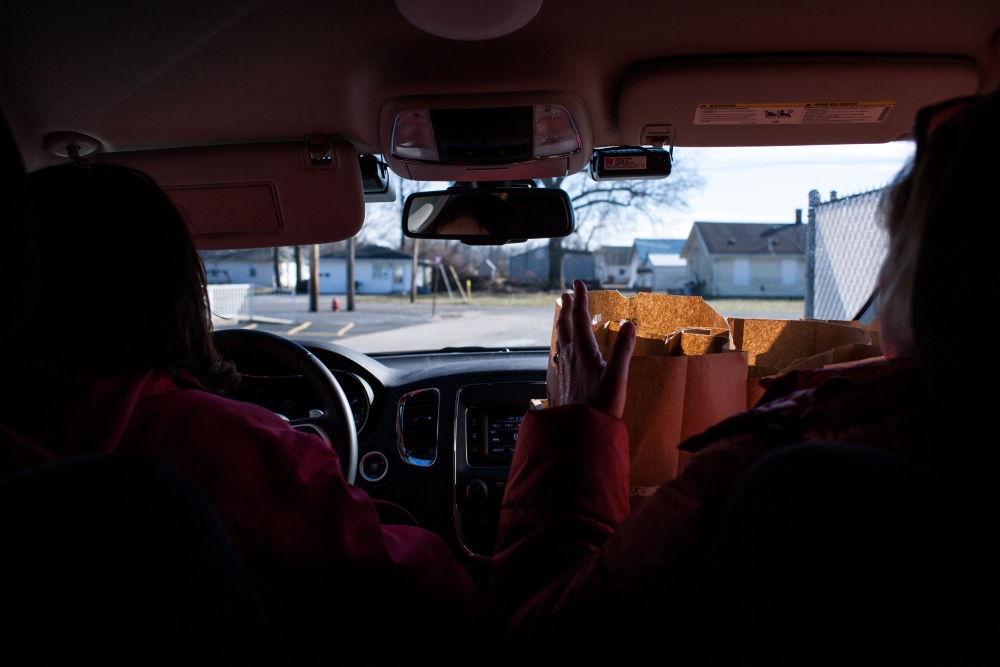
Druggies, those people have a problem. They should be left alone. Jackie said that’s how many people view the drug problem in Seymour, and until Taylor overdosed, Jackie was one of them.
At first she couldn’t understand Taylor’s heroin addiction. It made her mad. Once he got out of the hospital, she made his grandmother handle most of his affairs until she could let him tell her anything and have it not shock her.
“When someone overdoses and you realize you could’ve lost that person, then you realize you have to do whatever it takes to keep them alive,” Jackie said. “You have to come to their level.”
Since Taylor came home from jail after serving 90 daysfor unlawful possession of a syringe, Jackie has been right by his side during his recovery process. She sometimes goes with him to counseling, receives his random drug tests and goes with him to his mandatory court appearances on Wednesdays when she can get off work.
If anything, working with Taylor and others grappling with addiction has taught Jackie compassion.
The problem was the stigma around drug use; the negative connotation and social isolation. People were afraid to ask for help because then everyone would know.
It is this denial and fear of reaching out that Jackie says becomes a barrier to care. The key was not to push the addicts aside as though they could get clean on their own. Everyone needed to talk about it in a more tolerant way.
After the event and the publication of an interview with Taylor in the local Seymour Tribune, word of Jackie’s story spread. People from all over the community began to confide in her. If she could talk about it, so could they.
Like the retired drug counselor whose 16-year-old grandson overdosed on heroin.
The mother whose son was depressed and started using. She told Jackie about his overdose before telling his father.
The close friend who only recently admitted to suffering from addiction for three years.
The two people who overdosed within one week. A young man and woman close to Taylor’s age. One died on Saturday, the other on Monday.
It could happen to anyone.
“You don’t know the circumstances that got them into it,” Jackie said.
A few weeks after the Harmony Park event, a young woman walked into Jackie’s office.
“Are you Jackie who knows my mom?”
It was the daughter of Jackie’s former coworker, who had been desperately seeking news of her daughter.
Jackie had never met the woman before but immediately hugged her.
“Your mom is worried sick about you,” she said.

Jackie still keeps naloxone kits in her underwear drawer. She also keeps some in her car and in her husband, John's, and her daughter’s cars. She keeps them for Taylor, although she doesn’t want to have to use it on him again, and for the community.
She didn’t replenish the kit right after Taylor’s overdose. She didn’t think she’d ever need it again, but after Harmony Park, people began calling her, asking if she had any or knew where to find them.
She carried one in her purse and one in her car. In September, when she flew to Florida for her wedding, she packed one, just in case.
She’s already given out more than 25, and the calls keep coming.
Usually people call after an overdose has already happened. They want to make sure they have it on hand for the next time.
Jackie tells them the naloxone isn’t enough; they need to get into counseling. They have to own up to it and stop lying.
If nothing else, people need to get it out in the open, to be able to say: “You can tell me anything. I just don’t want you to die.”
She tells Taylor that all the time.
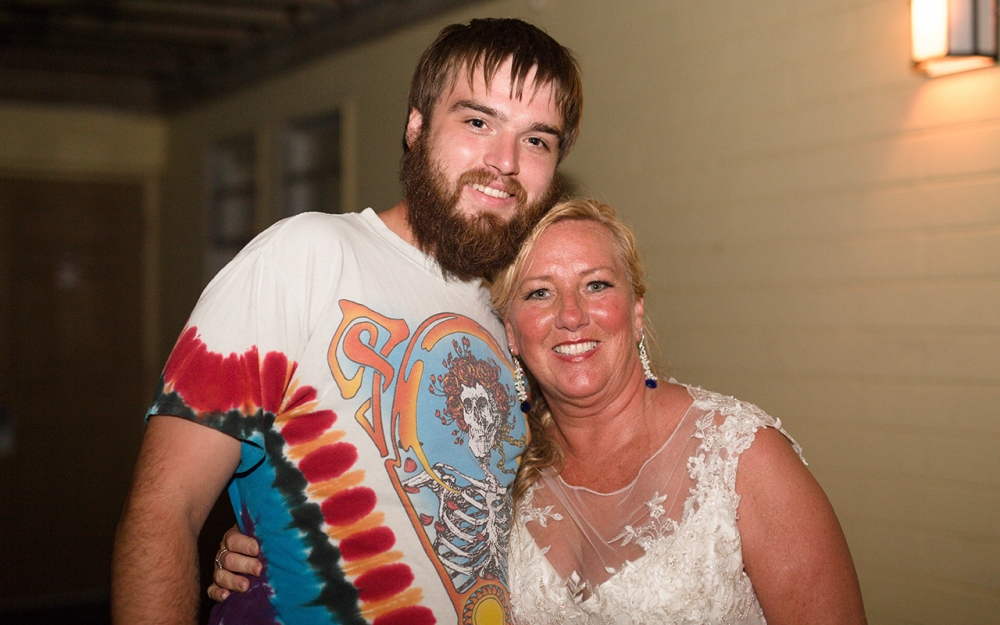
Jackie is no longer the person she was before all this happened.
She’s anxious and irritable. She has constant headaches. When she comes home from work, all she wants to do is sleep. She apologizes to her husband John. She used to be fun. They’d go out to listen to live music two or three times a week. Now she’d rather stay home so she’s available in a crisis.
Although Taylor is doing well in his recovery, it’s a daily struggle. His overdose left her with an overwhelming sadness, a constant grieving.
“I feel like I have a son with a terminal illness,” she said, “and that one day it’s going to kill him.”
It’s hard listening to everyone’s story and taking on their struggles without being able to tell anyone. She still has trouble talking about the night of Taylor’s overdose. She’s finally begun going to counseling for herself, to have someone to talk to.
Recently one of her patients in Scott County died. She and her coworkers attended his funeral. To her, it’s not just work.
She plans to host another event soon. She’ll tour grade schools to talk to middle school students and teenagers about preventative drug use with Overdose Lifeline. She hopes to help start a needle exchange program in Seymour and to provide more HIV testing.
There will always be more to be done for the community.
As Taylor put it: someone’s gotta do it.
“But you’re not embarrassed by me doing it, are you?” Jackie asks him.
No.
“Because I’m going to be doing more.”
